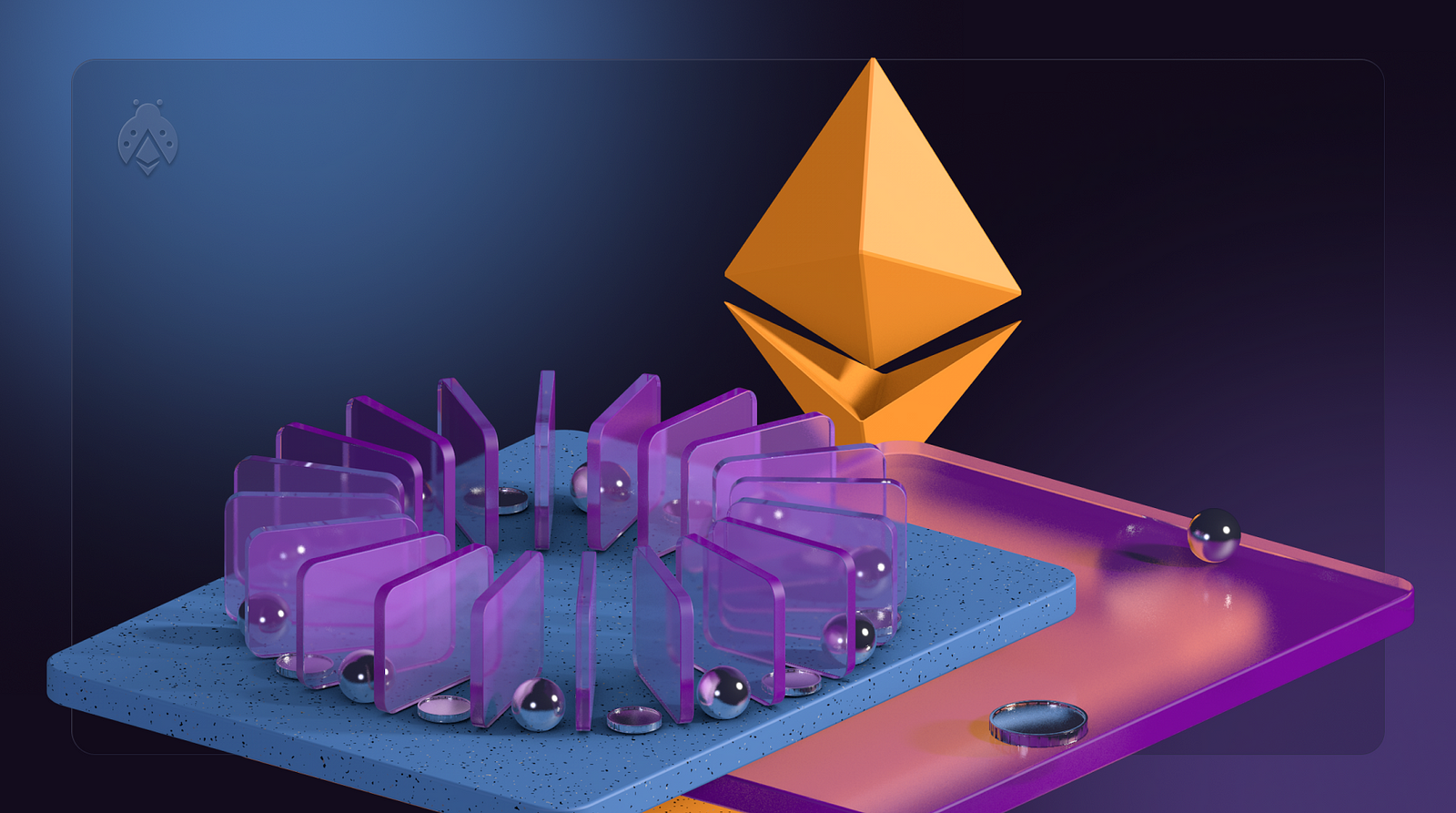Please fasten your belts!
Ethereum Shapella upgrade
The recent Ethereum upgrade, commonly referred to as the Shanghai upgrade, took place on April 12th and is considered one of the most important events in the crypto industry this year. The upgrade introduced a pivotal mechanical change in Ethereum’s network, and while there are several Ethereum Improvement Proposals (EIPs) included in the upgrade, one, in particular, is critical: EIP-4895.
Before the upgrade, Ethereum was using the proof-of-work consensus algorithm, but the plans to transition to proof-of-stake were already in play when developers created the Beacon Chain. The Beacon Chain is secured by PoS and needs validators to maintain its integrity, function as intended, and carry out transactions and smart contracts. Validators were able to stake 32 ETH to secure the Beacon chain and earn interest as a reward for securing the network during the development stage.
However, validators were not allowed to unstake their 32 ETH until a later, undetermined date, making their ETH illiquid. The Shanghai upgrade, through EIP-4895, finally allowed validators to unlock their ETH, making it entirely liquid. The Beacon depositor contract contained around 18 million ETH, roughly 15% of the total circulating supply, so this particular EIP was very important.

Validators can now withdraw their stake and do whatever they decide with it, but there are two types of withdrawals — full and partial:
- Full withdrawals allow validators to exit their stake completely, taking their entire balance of ETH, including the original 32 ETH, as well as any rewards they may have accrued.
- Partial ones only allow validators to access the excess (balances over the 32 ETH) needed to run a validator node.
Within every block added to the network, 16 validators can make partial withdrawals, and a total of 1,800 validators can unstake fully.
The other EIPs in the Shanghai upgrade were aimed at reducing gas fees during periods of high network congestion and activity:
- EIP-3651 aims to lower the gas costs associated with maximal Extractable Value payments when accessing the Coinbase address.
- EIP-3855 introduces a new instruction that pushes the constant value 0 onto the stack, reducing gas costs for developers.
- EIP-3860 and EIP-6049 aim to reduce fees in other instances.
The Shanghai (Shapella) upgrade is a landmark development for Ethereum, achieving security, decentralization, and scalability. It removes a significant burden on validators and provides a clear path forward for the network’s continued development.
EIP-1271
0xPass, a company that creates a unified ID for every user spanning their social accounts and wallet addresses, reminded its readers of EIP-1271 once again.
So we decided to tell our new subscribers what this Ethereum Proposal hides.
EIP-1271 is an Ethereum Improvement Proposal that specifies a standard interface that can be used by smart contracts to verify if a message or transaction is valid or not. This is important because it adds an extra layer of security to smart contracts and prevents unauthorized access or malicious behavior.
To use EIP-1271, you need to implement a function called isValidSignature in your smart contract, which takes a message hash and a signature as arguments and returns a four-byte code that indicates whether the signature is valid or not. This function uses cryptographic functions to verify the signature and returns the appropriate code.
EIP-1271 is important for the future of Ethereum because with the rise of smart contract wallets and DAOs controlled by multi-sigs, parties require the means to use signed messages to demonstrate the right to move assets, vote, or for other purposes. EIP-1271 is also the foundation for account abstraction, enabling the Ethereum ecosystem’s evolution.
Any dApp that wants to implement AA features to simplify the user experience and boost its capabilities should implement EIP-1271. By using this standard interface, developers can ensure that only authorized parties can perform certain actions in their smart contracts, which can help to prevent fraud or other malicious activities.
And here is what Vitalik thinks of this proposal.
The Etherspot team has created a website where anyone can check if a dApp supports EIP-1271. Let’s contribute to the Web3 future and encourage more dApps to integrate it!

Gnosis Builders: Exploring dApp Development with Etherspot
We are excited to share that Etherspot’s CEO, Michael Messele, recently had a Twitter Space session with Gnosis Builders called “Exploring dApp Development with Etherspot”.
During the session, Michael and Shantelle Awomoyi (Gnosis Ecosystem Builder) discussed the story behind Etherspot, Account Abstraction, dev tooling, and more. It was an insightful conversation that shed light on the latest developments in the dApp development space.
Michael also took the time to answer questions from the Gnosis community that they tweeted or posted in the Builders community. We are thrilled to offer you the recording of this engaging session, which you can access at the link.

AA in StarkNet
StarkNet, a blockchain project created by StarkWare, aims to enhance scalability, privacy, and security on the Ethereum blockchain.
One of the biggest issues with having custody of your crypto is the difficulty of navigating the technology, which could result in losing your digital assets forever. StarkNet integrates account abstraction, allowing users to combine user accounts and smart contracts into a single account.
This mechanism enables security mechanisms such as social recovery and multisigs, eliminating the need for users to use their private keys to sign off on every transaction.
StarkNet is a companion blockchain to Ethereum that natively integrates AA. Unlike Ethereum, which requires additional programming for AA integration, StarkNet enables users to use AA in their wallets without reprogramming them into smart contracts. This feature makes StarkNet more user-friendly and fail-safe for owning crypto.
Security checks for authorizing transactions and facial or fingerprint login are already available on StarkNet.
Undoubtedly, StarkNet is a 2023 Project to Watch.

AA on Intu
Intu, a promising Web3 project that focuses on creating better accounts with advanced functionality, has recently published an article on Medium. They discussed the differences and similarities between Coinbase’s Wallet as a Service (WaaS) and Intu, highlighting the importance of account abstraction and the role of externally-owned accounts (EOAs) in Web3 development.
The article also touches on both projects’ security and user experience improvements and their compatibility with existing Web3 infrastructure. In addition, Intu announced that it has successfully tested its distributed externally-owned accounts (dEOAs) protocol on Coinbase’s innovative Base blockchain, showcasing the protocol’s ability to work across even newly launched EVM chains.
The author emphasizes the crucial role of Intu and WaaS in providing better onboarding solutions for businesses and developers and promoting wider adoption of decentralized technologies in the Web3 ecosystem.
Subscribe to Etherspot’s Everything About Account Abstraction Newsletter!
Start exploring Account Abstraction with Etherspot!
- Learn more about account abstraction here.
- Head to our docs and read all about the Etherspot SDK.
- For a plug & play integration, review the BUIDLer react component.
- Explore our TransactionKit, a React library for fast & simple Web3 development.
- Follow us on Twitter and join our Discord.
❓Is your dApp ready for Account Abstraction? Check it out here: https://eip1271.io/
Get In Touch:
Website | Twitter | Discord | Github | Telegram
Powered by Etherspot
BUIDLer React Component | TransactionKit | Etherspot Dashboard | Pillar Wallet | AirdropMe

